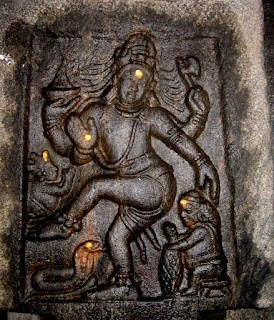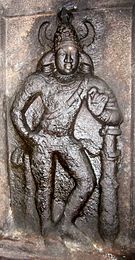ஆகமங்கள் போற்றும் நடராஜர் வடிவம் 1500 வருடம் முந்தையது.
A 1500-year-old dancing Shiva statue has been found in Vidisha district from Madhya Pradesh, which is being claimed to be the world's largest Nataraja statue.
மத்தியப்பிரதேச மாநிலம் விதிஷாவில் 9 × 4 மீட்டர் அளவிலான 1500 வருட பழமையான ஒரே கல்லில் செதுக்கிய நடராஜர் சிலை கிடைத்தது.
A huge statue of Lord Shiva's Nataraja form, about 1500 years old, has been found in Vidisha district of Madhya Pradesh. The statue is 9 meters long and 4 meters wide. Due to its large size, it was left in the ground as a pillar, but recently the state coordinator of INTECH Madan Mohan Upadhyay has revealed the mysterious pillar to be the largest statue of Nataraja.
Claiming to be the world's largest Nataraja statue, state coordinator of INTECH Upadhyay told that this huge statue has been constructed from a single rock. The statue is 9 meters long and 4 meters wide. The statue is so big in size that it was not easy to capture it in a frame, after inspecting it with a drone, it was found that it is a statue of Nataraja form of Lord Shiva.

Since last few years Intake is working at the site of Udaipur in Vidisha district. The idol of Nataraja is said to be before the Parmar period. Giving information, Madan Mohan Upadhyay said that Udaipur area is known for Neelkantheshwar Mahadev Temple, which is an ASI-protected monument. This temple attracts tourists. The story of the construction of this place has been written in the inscriptions including the Neelkantheshwar temple of Lord Shiva, which is now preserved in the Gwalior Museum.
The treasure of ancient heritage is hidden in the ruins
Madan Mohan Upadhyay said that there is a lot of potential to convert the ruins into a national and international tourist destination. The Indian National Trust for Art and Cultural Heritage (INTECH) has completed the work of documenting the ancient sites, the report of which will be submitted soon. This locality is 15 km from Ganjbasoda and 140 km from Bhopal. Vidisha District Administration, Madhya Pradesh Tourism Department and State Archaeological Department are working for the protection of this place.
Many secrets are buried in ancient remains
Spread over a thousand hectares, these ruins open many layers of history. Madan Mohan Upadhyay said that the structures surrounded by palaces, villages, fort walls, reservoirs, temples and innumerable buildings tell untold tales of the bygone times, showing the domination of different dynasties including the Parmars, Gonds and Marathas during different times. shows. He said that why the world's largest Nataraja statue was not installed at that time, it is a matter of research.
நடராஜர் வழிபாட்டு திருமேனி உருவத்தின் தொன்மை
இனித்தமுடன் எடுத்த பொற்பாதம்.எடுத்த பொற்பாதத்திற்கு என் இவ்வளவு பெருமை? ரிக்வேதம் இதற்கான பதிலளித் தருகிறது.
देवानां युगे प्रथमे असतः सदजायत |
तदाशा अन्वजायन्त तदुत्तानपदस परि ||
भूर्जज्ञ उत्तानपदो भुव आशा अजायन्त |
தேவர்களின் முதல் ஊழியில் பரம்பொருளில் இருந்து உயிர்கள் தோன்றின. திசைகள் தோன்றின. மேலே எடுத்த பாதத்திலிருந்து பூமியும் ஆகாயமும் தோன்றின.
இங்கே உத்தான பாதம் என்று கூறுவது இனித்தமுடன் எடுத்த பாதமல்லால் வேறென்ன
https://en.wikipedia.org/wiki/Avanibhajana_Pallaveshwaram_Temple

Asanpat Nataraja inscription 4th Century CE
Satrubhanja (Odia : ଶତ୍ରୁଭଞ୍ଜ) was a warrior and emperor who belonged to the Vindhyatabi branch of Nagavanshi rulers that ruled from Keonjhar district of Odisha in the early 4th century A.D (possibly between 261 A.D to 340 A.D).The era of Satrubhanja belongs to the pre Gupta rise as an imperial power in India when the other ruling Bharasiva Nagas of India joined hands to overthrow the ruling Devaputras of Pataliputra, also otherwise known as Kushan rulers to the modern historians.The Asanapat village dancing Nataraja Shiva inscription in Sanskrit Language with Post Brahmi or early Kalinga script of Satrubhanja provides a great deal of details about his achievements as a conqueror and spiritual man. The inscription is of thirteen lines which is written partly in verse and partly in prose.
The Asanpat inscription which is now kept in the Odisha state museum gives a detailed overview of Satrubhanja's life as ruler and warrior. He is described as born like moon among kings in the Naga clan and as the distinguished Ranaslaghin (one who boasts of battle), an epithet given to Bhishma in the Mahabharata.[5] He is also described as a divine child born to a family the fame of which would last till the end of the Kali yuga. Probably he belonged to a very high class Naga clan family and according to the inscription was expected to win battles with the enemies in the future. Satrubhanja is described as the ruler of Vindhyatabi (Keonjhar and adjoining modern Mayurbhanj - Singhbhum districts). He was the son of Maharaja Manabhanja and the queen Mahadevi Damayanti. He was a successful warrior who is defined by the statement that his heroism remains unchallenged even after hundreds of battles with the Murundas and Kushans. He is described as the Kalpavriksha who possessed the quality of good wealth on earth similar to the sun having mass splendor on earth
The inscription written in 13 lines in Sidhamatrika script below the image of Lord Siva in Tandava dance pose was recovered from the village Asanapata in Keonjhar district. The discovery of this inscription reveals a new line of kings of the Naga ruling family reigning in a territory comprising Bindhyatavi region during the 5th century A.D. It relates to the glorious achievements of its donor, Satrubhanja whose sphere of influence was extended as far as Ubhaya Toshali, Pataliputra, Tamralipti. Gaya, Pundravardhana, Vardhamana, Krimila, etc., (comprising the entire eastern region of India). The Siva image in question below which the inscription is incised, represents in his eight hands, snake, veena, varada, trisula, akshamala and damaru associated with Nandi and a devotee.
https://odishamuseum.nic.in/?q=node/48
Avanibhajana Pallaveshwaram Temple






No comments:
Post a Comment